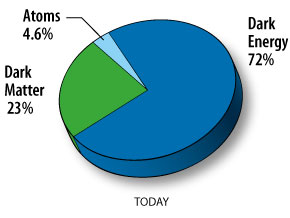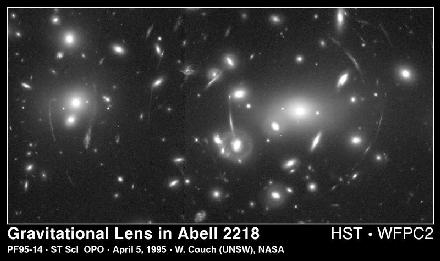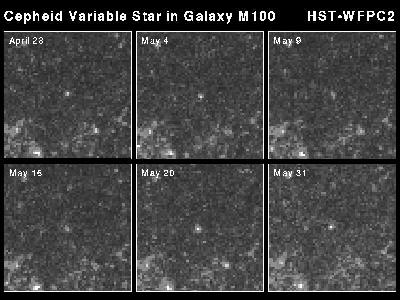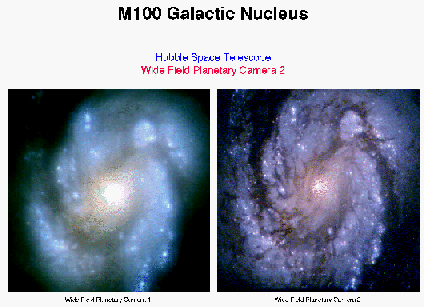Our Universe
So far, we have only described the Big Bang model in general terms: on the largest scales we can observe, the universe appears nearly uniform, it is currently expanding, and there is strong evidence that it was hotter and denser in the past. Now we would like the answers to some more specific questions:
- What types of matter and energy fill the universe? How much of each?
- How rapidly is the universe expanding today?
- How old is the universe today?
- What is the overall shape of the universe? Open, flat, closed, or otherwise?
- How is the expansion changing with time?
- What is the ultimate fate of the universe?
In this section, we address each of these questions in turn by summarizing the observations that inform each of these questions. There are many useful probes of the nature of our universe, each of which constrains one or more particular aspects of the Big Bang model and our understanding of structure formation. Indeed, the coming decade is being dubbed the era of precision cosmology as observations of supernova, galaxies and clusters, the cosmic microwave background radiation and the abundance of light elements each becomes mature. Taken together, these data will strongly constrain the model of our universe and may even point to the need for a radical rethinking of our understanding of cosmology.
What is the Universe Made Of?
One of the key questions that needs to be answered by astrophysicists is what is really out there? And of what is it all made? Without this understanding it is impossible to come to any firm conclusions about how the universe evolved.PROTONS, NEUTRONS AND ELECTRONS: THE STUFF OF LIFE
You, this computer, the air we breathe, and the distant stars are all made up of protons, neutrons and electrons. Protons and neutrons are bound together into nuclei and atoms are nuclei surrounded by a full complement of electrons. Hydrogen is composed of one proton and one electron. Helium is composed of two protons, two neutrons and two electrons. Carbon is composed of six protons, six neutrons and six electrons. Heavier elements, such as iron, lead and uranium, contain even larger numbers of protons, neutrons and electrons. Astronomers like to call all material made up of protons, neutrons and electrons "baryonic matter".
Until about thirty years ago, astronomers thought that the universe was composed almost entirely of this "baryonic matter", ordinary atoms. However, in the past few decades, there has been ever more evidence accumulating that suggests there is something in the universe that we can not see, perhaps some new form of matter.
WMAP AND DARK MATTER / DARK ENERGY
 By making accurate measurements of the cosmic microwave background fluctuations, WMAP is able to measure the basic parameters of the Big Bang model including the density and composition of the universe. WMAP measures the relative density of baryonic and non-baryonic matter to an accuracy of better than a few percent of the overall density. It is also able to determine some of the properties of the non-baryonic matter: the interactions of the non-baryonic matter with itself, its mass and its interactions with ordinary matter all affect the details of the cosmic microwave background fluctuation spectrum.
By making accurate measurements of the cosmic microwave background fluctuations, WMAP is able to measure the basic parameters of the Big Bang model including the density and composition of the universe. WMAP measures the relative density of baryonic and non-baryonic matter to an accuracy of better than a few percent of the overall density. It is also able to determine some of the properties of the non-baryonic matter: the interactions of the non-baryonic matter with itself, its mass and its interactions with ordinary matter all affect the details of the cosmic microwave background fluctuation spectrum.
WMAP determined that the universe is flat, from which it follows that the mean energy density in the universe is equal to the critical density (within a 1% margin of error). This is equivalent to a mass density of 9.9 x 10-30 g/cm3, which is equivalent to only 5.9 protons per cubic meter. Of this total density, we now know the breakdown to be:
- 4.6% Atoms. More than 95% of the energy density in the universe is in a form that has never been directly detected in the laboratory! The actual density of atoms is equivalent to roughly 1 proton per 4 cubic meters.
- 23% Cold Dark Matter. Dark matter is likely to be composed of one or more species of sub-atomic particles that interact very weakly with ordinary matter. Particle physicists have many plausible candidates for the dark matter, and new particle accelerator experiments are likely to bring new insight in the coming years.
- 72% Dark Energy. The first observational hints of dark energy in the universe date back to the 1980's when astronomers were trying to understand how clusters of galaxies were formed. Their attempts to explain the observed distribution of galaxies were improved if dark energy was present, but the evidence was highly uncertain. In the 1990's, observations of supernova were used to trace the expansion history of the universe (over relatively recent times) and the big surprise was that the expansion appeared to be speeding up, rather than slowing down! There was some concern that the supernova data were being misinterpreted, but the result has held up to this day. In 2003, the first WMAP results came out indicating that the universe was flat (see above) and that the dark matter made up only ~23% of the density required to produce a flat universe. If 72% of the energy density in the universe is in the form of dark energy, which has a gravitationally repulsive effect, it is just the right amount to explain both the flatness of the universe and the observed accelerated expansion. Thus dark energy explains many cosmological observations at once.
- Fast moving neutrinos do not play a major role in the evolution of structure in the universe. They would have prevented the early clumping of gas in the universe, delaying the emergence of the first stars, in conflict with the WMAP data. However, with 5 years of data, WMAP is able to see evidence that a sea of cosmic neutrinos do exist in numbers that are expected from other lines of reasoning. This is the first time that such evidence has come from the cosmic microwave background.
ANOTHER PROBE OF DARK MATTER
By measuring the motions of stars and gas, astronomers can "weigh" galaxies. In our own solar system, we can use the velocity of the Earth around the Sun to measure the Sun's mass. The Earth moves around the Sun at 30 kilometers per second (roughly sixty thousand miles per hour). If the Sun were four times more massive, then the Earth would need to move around the Sun at 60 kilometers per second in order for it to stay on its orbit. The Sun moves around the Milky Way at 225 kilometers per second. We can use this velocity (and the velocity of other stars) to measure the mass of our Galaxy. Similarly, radio and optical observations of gas and stars in distant galaxies enable astronomers to determine the distribution of mass in these systems.
The mass that astronomers infer for galaxies including our own is roughly ten times larger than the mass that can be associated with stars, gas and dust in a Galaxy. This mass discrepancy has been confirmed by observations of gravitational lensing, the bending of light predicted by Einstein's theory of general relativity.
HST Image of a gravitational lens
Text Link for an HST press release describing this image.
By measuring how the background galaxies are distorted by the foreground cluster, astronomers can measure the mass in the cluster. The mass in the cluster is more than five times larger than the inferred mass in visible stars, gas and dust.
CANDIDATES FOR THE DARK MATTER
What is the nature of the "dark matter", this mysterious material that exerts a gravitational pull, but does not emit nor absorb light? Astronomers do not know.
There are a number of plausible speculations on the nature of the dark matter:
- Brown Dwarfs: if a star's mass is less than one twentieth of our Sun, its core is not hot enough to burn either hydrogen or deuterium, so it shines only by virtue of its gravitational contraction. These dim objects, intermediate between stars and planets, are not luminous enough to be directly detectable by our telescopes. Brown Dwarfs and similar objects have been nicknamed MACHOs (MAssive Compact Halo Objects) by astronomers. These MACHOs are potentially detectable by gravitational lensing experiments. If the dark matter is made mostly of MACHOs, then it is likely that baryonic matter does make up most of the mass of the universe.
- Supermassive Black Holes: these are thought to power distant k quasars. Some astronomers speculate that there may be copious numbers of black holes comprising the dark matter. These black holes are also potentially detectable through their lensing effects.
- New forms of matter: particle physicists, scientists who work to understand the fundamental forces of nature and the composition of matter, have speculated that there are new forces and new types of particles. One of the primary motivations for building "supercolliders" is to try to produce this matter in the laboratory. Since the universe was very dense and hot in the early moments following the Big Bang, the universe itself was a wonderful particle accelerator. Cosmologists speculate that the dark matter may be made of particles produced shortly after the Big Bang. These particles would be very different from ordinary "baryonic matter". Cosmologists call these hypothetical particles WIMPs (for Weakly Interacting Massive Particles) or "non-baryonic matter".
DARK ENERGY: A COSMOLOGICAL CONSTANT?
Dark Energy makes up a large majority ot the total content of the universe, but this was not always known. Einstein first proposed the cosmological constant (not to be confused with the Hubble Constant) usually symbolized by the greek letter "lambda" (Λ), as a mathematical fix to the theory of general relativity. In its simplest form, general relativity predicted that the universe must either expand or contract. Einstein thought the universe was static, so he added this new term to stop the expansion. Friedmann, a Russian mathematician, realized that this was an unstable fix, like balancing a pencil on its point, and proposed an expanding universe model, now called the Big Bangtheory. When Hubble's study of nearby galaxies showed that the universe was in fact expanding, Einstein regretted modifying his elegant theory and viewed the cosmological constant term as his "greatest mistake".
Many cosmologists advocate reviving the cosmological constant term on theoretical grounds, as a way to explain the rate of expansion of the universe. Modern field theory associates this term with the energy density of the vacuum. For this energy density to be comparable to other forms of matter in the universe, it would require new physics theories. So the addition of a cosmological constant term has profound implications for particle physics and our understanding of the fundamental forces of nature.
The main attraction of the cosmological constant term is that it significantly improves the agreement between theory and observation. The most spectacular example of this is the recent effort to measure how much the expansion of the universe has changed in the last few billion years. Generically, the gravitational pull exerted by the matter in the universe slows the expansion imparted by the Big Bang. Very recently it has become practical for astronomers to observe very bright rare stars called supernova in an effort to measure how much the universal expansion has slowed over the last few billion years. Surprisingly, the results of these observations indicate that the universal expansion is speeding up, or accelerating! While these results should be considered preliminary, they raise the possibility that the universe contains a bizarre form of matter or energy that is, in effect, gravitationally repulsive. The cosmological constant is an example of this type of energy. Much work remains to elucidate this mystery!
There are a number of other observations that are suggestive of the need for a cosmological constant. For example, if the cosmological constant today comprises most of the energy density of the universe, then the extrapolated age of the universe is much larger than it would be without such a term, which helps avoid the dilemma that the extrapolated age of the universe is younger than some of the oldest stars we observe! A cosmological constant term added to the standard model Big Bang theory leads to a model that appears to be consistent with the observed large-scale distribution of galaxies and clusters, with WMAP's measurements of cosmic microwave background fluctuations, and with the observed properties of X-ray clusters.
How Fast is the Universe Expanding?
The expansion or contraction of the universe depends on its content and past history. With enough matter, the expansion will slow or even become a contraction. On the other hand, dark energy drives the universe towards increasing rates of expansion. The current rate of expansion is usually expressed as the Hubble Constant (in units of kilometers per second per Megaparsec, or just per second).
Hubble found that the universe was not static, but rather was expanding!
HISTORICAL OVERVIEW
In the 1920s, Edwin Hubble, using the newly constructed 100" telescope at Mount Wilson Observatory, detected variable stars in several nebulae. Nebulae are diffuse objects whose nature was a topic of heated debate in the astronomical community: were they interstellar clouds in our own Milky Way galaxy, or whole galaxies outside our galaxy? This was a difficult question to answer because it is notoriously difficult to measure the distance to most astronomical bodies since there is no point of reference for comparison. Hubble's discovery was revolutionary because these variable stars had a characteristic pattern resembling a class of stars called Cepheid variables. Earlier, Henrietta Levitt, part of a group of female astronomers working at Harvard College Observatory, had shown there was a tight correlation between the period of a Cepheid variable star and its luminosity (intrinsic brightness). By knowing the luminosity of a source it is possible to measure the distance to that source by measuring how bright it appears to us: the dimmer it appears the farther away it is. Thus, by measuring the period of these stars (and hence their luminosity) and their apparent brightness, Hubble was able to show that these nebula were not clouds within our own Galaxy, but were external galaxies far beyond the edge of our own Galaxy.
Hubble's second revolutionary discovery was based on comparing his measurements of the Cepheid-based galaxy distance determinations with measurements of the relative velocities of these galaxies. He showed that more distant galaxies were moving away from us more rapidly:
v = Hod
where v is the speed at which a galaxy moves away from us, and d is its distance. The constant of proportionality Ho is now called the Hubble constant. The common unit of velocity used to measure the speed of a galaxy is km/sec, while the most common unit of for measuring the distance to nearby galaxies is called the Megaparsec (Mpc) which is equal to 3.26 million light years or 30,800,000,000,000,000,000 km! Thus the units of the Hubble constant are (km/sec)/Mpc.
This discovery marked the beginning of the modern age of cosmology. Today, Cepheid variables remain one of the best methods for measuring distances to galaxies and are vital to determining the expansion rate (the Hubble constant) and age of the universe.
WHAT ARE CEPHEID VARIABLES?
The structure of all stars, including the Sun and Cepheid variable stars, is determined by the opacity of matter in the star. If the matter is very opaque, then it takes a long time for photons to diffuse out from the hot core of the star, and strong temperature and pressure gradients can develop in the star. If the matter is nearly transparent, then photons move easily through the star and erase any temperature gradient. Cepheid stars oscillate between two states: when the star is in its compact state, the helium in a layer of its atmosphere is singly ionized. Photons scatter off of the bound electron in the singly ionized helium atoms, thus, the layer is very opaque and large temperature and pressure gradients build up across the layer. These large pressures cause the layer (and the whole star) to expand. When the star is in its expanded state, the helium in the layer is doubly ionized, so that the layer is more transparent to radiation and there is much weaker pressure gradient across the layer. Without the pressure gradient to support the star against gravity, the layer (and the whole star) contracts and the star returns to its compressed state.
Cepheid variable stars have masses between five and twenty solar masses. The more massive stars are more luminous and have more extended envelopes. Because their envelopes are more extended and the density in their envelopes is lower, their variability period, which is proportional to the inverse square root of the density in the layer, is longer.

Text Link to the HST press release describing this image.
DIFFICULTIES IN USING CEPHEIDS
There have been a number of difficulties associated with using Cepheids as distance indicators. Until recently, astronomers used photographic plates to measure the fluxes from stars. The plates were highly non-linear and often produced faulty flux measurements. Since massive stars are short lived, they are always located near their dusty birthplaces. Dust absorbs light, particularly at blue wavelengths where most photographic images were taken, and if not properly corrected for, this dust absorption can lead to erroneous luminosity determinations. Finally, it has been very difficult to detect Cepheids in distant galaxies from the ground: Earth's fluctuating atmosphere makes it impossible to separate these stars from the diffuse light of their host galaxies.
Another historic difficulty with using Cepheids as distance indicators has been the problem of determining the distance to a sample of nearby Cepheids. In recent years, astronomers have developed several very reliable and independent methods of determining the distances to the Large Magellanic Cloud (LMC) and Small Magellanic Cloud (SMC), two of the nearby satellite galaxies of our own Milky Way Galaxy. Since the LMC and SMC contain large number of Cepheids, they can be used to calibrate the distance scale.
RECENT PROGRESS
Recent technological advances have enabled astronomers to overcome a number of the other past difficulties. New detectors called CCDs (charge coupled devices) made possible accurate flux measurements. These detectors are also sensitive in the infrared wavelengths. Dust is much more transparent at these wavelengths. By measuring fluxes at multiple wavelengths, astronomers were able to correct for the effects of dust and make much more accurate distance determinations.
These advances enabled more accurate study of the nearby galaxies that comprise the "Local Group" of galaxies. Astronomers observed Cepheids in both the metal rich inner region of the Andromeda galaxy and its metal poor outer region. (To an astronomer, a "metal" is any element heavier than helium - the second lightest element in the periodic table. Such elements are produced in stars and are ultimately released into the interstellar medium as the stars evolve.) This work showed that the properties of Cepheids did not depend sensitively on chemical abundances. Despite these advances, astronomers, limited by the Earth's atmosphere, could only measure the distances to the nearest galaxies. In addition to the motion due to the expansion of the universe, galaxies have "relative motions" due to the gravitational pull of their neighbors. Because of these "peculiar motions", astronomers need to measure the distances to distant galaxies so that they can determine the Hubble constant.
Trying to push deeper into the universe, astronomers have developed a number of new techniques for determining relative distances to galaxies: these independent relative distance scales now agree to better than 10%. For example, there is a very tight relation, called the Tully-Fisher relation, between the rotational velocity of a spiral galaxy and its luminosity. Astronomers also found that Type Ia supernova, which are thought to be due to the explosive burning of a white dwarf star, all had nearly the same peak luminosity. However, without accurate measurements of distance to large numbers of prototype galaxies, astronomers could not calibrate these relative distance measurements. Thus, they were unable to make accurate determinations of the Hubble constant.
Over the past few decades, leading astronomers, using different data, reported values for the Hubble constant that varied between 50 (km/sec)/Mpc and 100 (km/sec)/Mpc. Resolving this factor of two discrepancy was one of the most important outstanding problems in observational cosmology.
HUBBLE KEY PROJECT
One of the "key projects" of the Hubble Space Telescope was to complete Edwin Hubble's program of measuring distances to nearby galaxies. While the Hubble Space Telescope (HST) is comparable in diameter to Hubble's telescope on Mount Wilson, it had the advantage of being above the Earth's atmosphere, rather then being located on the outskirts of Los Angeles. NASA's repair of the Hubble Space Telescope restored its vision and enabled the key project program. The photos below show before and after images of M100, one of the nearby galaxies observed by the key project program. With the refurbished HST, it was much easier to detect individual bright stars in M100, a necessary step in studying Cepheid variables. The project also checked to see if the properties of Cepheid variables are sensitive to stellar composition.
HST image of M100 before and after repair
Text Link to the HST press release describing this image.
Overall, the key project attempted to get distances to 20 nearby galaxies. With this large sample, the project calibrated and cross checked a number of the secondary distance indicators. Because M100 is close enough to us that its peculiar motion is a significant fraction of its Hubble expansion velocity, the key project team used relative distance indicators to extrapolate from the Virgo cluster, a nearby cluster of galaxies containing M100, to the more distant Coma cluster and to obtain a measurement of the Hubble constant of 70 (km/sec)/Mpc, with an uncertainty of 10%.
The key project determination of the Hubble constant is consistent with a number of independent efforts to estimate the Hubble constant: a statistical synthesis by G.F.R. Ellis and his collaborators of the published literature yielded a value between 66 and 82 (km/sec)/Mpc. However, there was still not complete consensus on the value of the Hubble constant.
WMAP AND THE HUBBLE CONSTANT
By characterizing the detailed structure of the cosmic microwave background fluctuations, WMAP has accurately determined the basic cosmological parameters, including the Hubble constant, to better than 5%. This measurement is completely independent of traditional measurements using Cepheid variables and other techniques. The current results show the Hubble Constant to be 73.5 (km/sec)/Mpc (give or take 3.2 (km/sec)/Mpc). If the WMAP data is combined with other cosmological data, the best estimate is 70.8 (km/sec)/Mpc (give or take 1.6 (km/sec)/Mpc). These results assume that the universe is spatially flat, which is consistent with all available data. However, if we do not make this assumption, the uncertainty in the Hubble constant increases to 4 (km/sec)/Mpc, or slightly over 5%.
